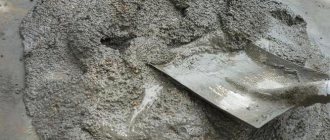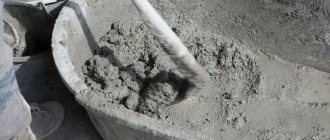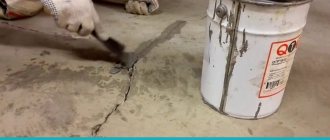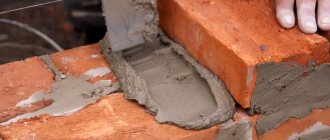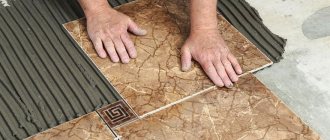Cement M200 belongs to plaster and masonry mixtures and is intended for the formation of cement screeds, laying small building blocks (bricks, etc.), as well as for performing masonry, plastering and other types of work. The base can be concrete and brick surfaces of sufficient strength. You can also read about cement M500 M600: differences, technical characteristics, instructions.
M200 cement properties differ from the technical characteristics of some mineral components (gypsum or air lime), because it has the ability to gain strength even in wet conditions. Also read what are the differences between M300 and M400 cements here.
Historical information
The Romans were not the first to experiment with lime, mixing some components into it to give the material the appropriate properties. Later, in the Middle Ages, it was discovered that the products of limestone firing were not inferior in water resistance to the volcanic pozzolanic mixtures of the resourceful Romans.
The founder of the modern cement industry can rightfully be called the chemist A.R. Shulyachenko, and the Antonov lime kiln is widely used in the production of clinker. Well-known chemists I. F. Ponomarev, Yu. M. Butt, S. M. Royak, etc. devoted a lot of time to the issues of technology for the production of cement and the hardening of hydraulic binder mixtures in the Soviet Union.
Production
A dry, powdery, finely dispersed mixture is obtained by grinding silicate clinker and gypsum (it regulates the curing time of the future solution). Subsequently, the resulting raw material is fired at a temperature of 1450 - 1480°C. To improve individual properties and reduce the cost of the final product, up to 15% active additives are added to the mixture (for example, bauxite, sand, pyrite cinders, flasks, etc.).
At all stages of production, M200 cement has a composition similar to other brands of cement, however, at the final stage, various components are added to the feedstock, which determines the further labeling of the material.
Specifications
Cement M200 technical characteristics comply with GOST 28013-98. One of the decisive parameters is the strength of the material. Thus, with close interaction with liquids (water, salt solutions, etc.), a dry gray mixture of artificial origin forms a plastic viscous mass, which over time turns into a visible material in stone.
M200 cement technical specifications depend mainly on the solidification temperature of the solution. In addition, the most important factor influencing the setting speed of cement mortar are special additives that accelerate or slow down the hardening process. You can also find out why M700 cement is better than other materials.
For the material cement M200, the solidification temperature and “setting” time after mixing are shown in the table:
| M200 | Air temperature, оС | First “setting” time, min. | Final setting time, min. |
| approaches + 20оС | 2 hours | 3 hours after mixing | |
| approaching 0°C | 6-10 hours | 20 hours after mixing |
Technical conditions of use
In order to correctly use cement M 200 mortar, the technical characteristics of which would meet all GOST requirements and technical specifications, it is necessary to follow the sequence of its preparation. In particular:
- Add dry cement powder only to clean, cold water (not vice versa!).
- It is necessary to dilute the mixture mechanically (with a construction mixer, drill attachment) until a homogeneous mass is obtained, avoiding clumping of the powder.
- The holding time of the solution is no more than 5 minutes, after which the concrete mixture should be mixed again.
- Remember that the time for the first “setting” of the solution occurs after 2 hours, and the time to gain full strength is at least 28 days.
- Cement mortar should be applied to previously cleaned and prepared surfaces at a temperature not lower than +5°C to avoid the formation of cracks.
Cement mortar M200
Ordering options: 1. By phone; 2. Leave a request via the order form; 3. Write to us by email.
Delivery in Khabarovsk: • Delivery is carried out by 5m3 vat mixers; • The cost of delivering 1 cubic meter of concrete within the city is 600 rubles/m3 (excluding VAT), 700 rubles/m3 (including VAT); • Delivery outside the city is calculated individually.
Payment: We have several payment options available for goods: 1. Cash; 2. To a current account; 3. Cashless transfer (acquiring). Detailed information by phone on the website.
- Description
Cement mortar M200
Cement mortar grade M200 is a complex mixture corresponding to index B15. Its main feature is its high technical parameters and characteristics, which are perfectly combined with an affordable price. The strength of this composition is quite sufficient for use in low-rise construction.
M200 mortar is often referred to as masonry, plaster or construction mortar. If the material contains sand with a large particle size modulus, it is also called sand concrete or fine-grained concrete.
| Brand of cement mortar | Price for 1m3 / rub | |
| Without delivery | With delivery throughout the city | |
| Cement mortar M200 | 4650 RUR | 5450 rub. |
You can find out the current cost of goods from a consultant by phone: +7 (4212) 929-659
Scope of application
Cement mortar M200 is indispensable for:
- masonry of all types of walls and partitions;
- screeding and leveling of floors;
- covering surfaces with tile materials and natural stone;
- plastering walls, slopes, various surfaces;
- production of stone and brick structures;
- hydraulic equipment for swimming pools, water parks, shower rooms, etc.
Composition and main characteristics of M200 cement mortar
The main components of the solution are cement, water and construction sand. When combined, these components give the finished material reliability and make it more moisture resistant.
M200 is produced from coarse, washed-up mountain sand, since river sand is not able to provide sufficient strength. This sand does not have foreign impurities that reduce the strength of the finished mixture. To change the properties of the finished composition, it is supplemented with special additives.
Mortar M200 is endowed with the following characteristics:
- composition strength class – B15;
- frost resistance – F100;
- water resistance – W4;
- mobility – P2-P4;
- average weight per cubic meter is 2100 kg.
The number 200, present in the brand name, indicates the strength of the composition after its compression. In the hardened state, this material is resistant to moisture and is also endowed with high heat resistance.
Having been on the construction market for 13 years, it has managed to establish itself as a responsible and conscientious manufacturer (supplier) of cement mortars, including the M200 brand.
To buy mortar in Khabarovsk, as well as get comprehensive advice, just contact our managers. We are ready to work on favorable terms, both with private builders and with contractors. Regular customers can count on installment payments.
Due to the fact that we produce the products ourselves and do not need the services of intermediaries, the price of cement mortar is quite reasonable. And having our own fleet of vehicles allows for prompt delivery throughout Russia.
Call us at +7 (4212) 929-659 or leave a request on the website!
Purpose
Cement-sand mixture is widely used. In particular, cement grade 200 is intended for:
- execution of masonry and plastering works;
- installation of concrete floor surfaces;
- construction of light foundations;
- paving sidewalk paths with tiles;
- processing of seams during the repair of concrete and reinforced concrete products (sealing chips, cracks).
What is M200 cement used for, considering that M200 cement shows weak characteristics? The answer is simple, because it is the marking of the material that indicates the maximum permissible load of 200 kg/cubic meter, which it can withstand after the solution has dried. This means that such cement is aimed, to a greater extent, at performing small-scale construction and household works. For comparison, durable cement grades M350 and M500 are used at construction sites (their maximum load is 350 and 500 kg/cub.m).
However, PCT 200 cement (Portland backfill cement) is not recommended for use in critical building structures if temperature changes are expected (frequent freezing/thawing). But Portland cement cement PC 200 is successfully used where the surfaces of structures are exposed to fresh water (underground or in water). You can also learn more about white cement by following this link.
Several recommendations when working with M200 cement:
- During the “setting” process, the mobility of the concrete is maintained!
- A thickened cement solution becomes unsuitable for further use!
- When buying cement with the designations M400 or M500, you can “run into” sand concrete of the cement 200 brand. This happens, as a rule, through the fault of unscrupulous dealers who seek to purchase lower-grade material (M200 or M300) from the manufacturer in order to safely package it in packaging of expensive cement.
- As recommendations, I would like to note that choosing a reliable cement supplier is possible! It is enough to study the pricing policy of market sales. Cement 200 price below cost should alert and warn against purchasing low-quality material.
- When working with M200 dry mixes, as with any other brands of cement, it is necessary to avoid getting the powder in the eyes. During the preparation of cement mortar, caustic alkali is released, so you should always have the necessary protective equipment. If cement gets into your eyes, rinse them immediately with clean water.
Consumption of components per cube of concrete
When purchasing materials for concrete, first determine how much solution is needed, and then calculate the materials for it. Sand and crushed stone can be taken with some reserve - they are still needed for backfilling and other construction work. Although, if you look at the average, one cubic meter of M200 concrete contains 1060 kg of crushed stone and 900 kg of sand.
It is better to take cement “as soon as possible.” This material loses its strength significantly during long-term storage. So, three months after the production date, its strength becomes lower by 20%, after six months the loss is 30%, and after a year - 50%. So, firstly, you need to buy fresh cement, and secondly, it’s better not to take too much.
Consumption of cement for concrete grade M200 per cubic meter of solution
To find out how much cement you will need for your work, multiply the number of cubes by the consumption rate. It can be in kilograms or bags. But keep in mind that packaging can be either 40 kg or 25 kg. So you need to remember the number in kilograms.
Conclusion
The most popular cement in the field of construction, M200, is an inorganic, unmodified material that, during the preparation of the solution, forms a viscous mass with a strength after drying of 20 MPa.
Basically, cements of this grade are used for the preparation of building mortars (CPS and concrete), since the relatively low cost of the material allows a wide range of construction work to be performed at minimal cost. You can also find out about the technical characteristics of M400 cement by clicking here.
Composition and proportions
Like all others, concrete grade B15 M200 consists of a binder - cement, aggregates - sand and crushed stone. All these components are mixed and diluted with clean water to form a batter or thick sour cream. In general, the density may vary depending on the requirements. For example, formwork with reinforcement requires a more fluid composition, since the solution must fill the space between the reinforcing rods.
Concrete M200 - proportions for cement M400 and M500
The tables show only dry ingredients. Water is added based on the required hardness of the solution. The average water-cement ratio is 0.6. This means that water should be taken 0.6 by weight of cement. To put it simply, add 600 ml of water per 1 kg of cement. To begin with, you should measure out this amount. Add half of it to the concrete mixer at once, then in small portions until the desired consistency is reached. As a result, there may be a little more or a little less water. Even the humidity of the sand affects its quantity.
The composition of concrete grade 200 in the table is given both in mass fractions and in volume fractions. When purchasing, it is more convenient to handle kilograms, and they are usually poured into a concrete mixer with buckets or shovels. Volume fractions are more useful here.

